Trees in My Nature Journal
A practice of loving, letting go and letting be
Photo Caption: In my hand I am holding a water brush, a brush pen, and my small handmade journal on which is a n unfinished sketch of a conifer tree. In the background is a the tree in the real world standing in front of a dilapidated building.
Hello Nature + Art + Journaling Loving Friends,
It’s been a very long time since my last post. I had a lot going on last year so I listened to my body and gave myself permission to take a bunch of things off my plate. This included writing this Substack.
In this first post of 2025 I’m focusing on trees, namely why and how I love to sketch them in my journals.
I expect that anyone who has taken an introductory botany or biology class in High School or college, already knows some about why trees are critical to life on earth: converting carbon dioxide to oxygen and providing us with food, and for other animals, homes and food too, for example. Depending on when you were in high school1 you might also know about the role trees play in combating climate change.
More recently, I learned that trees also bring the temperature down in urban areas and reduce crime rates and, in the 1980’s, in a practice called Shinrin Yoku, loosely translated into ‘forest bathing,’ Japanese physicians began prescribing walks in the forest to help reduce symptoms of stress.
That’s just a small bit about why I love trees. Trees are among my favorite beings to meet when I’m out walking. And that’s why trees feature a lot in my nature journals.
When I’m out nature journaling and I want to capture trees, my HOW is summarized this way: loosely, with minimal materials and with a lot of interplay between the actual tree I am observing and my stored memories of all the trees I’ve ever noticed and stopped to study.
In the photo example above I used just three things: a small handmade sketchbook, a water brush, and a “calligraphy” brush pen. It’s unfinished. I did it in about 5 minutes because we - spouse, doggie, and I - rented a private dog park in the country and were early for our appointment. Happily, there was a small grouping of trees near the spot where we parked to wait.2
While sketching, I toggled back and forth between the brush pen and the water brush, making marks that I hoped would capture the general personality of the tree. I paid attention to the areas of shadow and areas of light. I never aim to capture every detail of needles, branches, and growth habit.3 What I focus on instead is creating a sketch that expresses what I find beautiful about the tree. I always deliberately leave details out and when a mark doesn’t go down on the page quite how I wanted it, I’ve learned to love these accidents and practice letting it go and letting it be. I work with the accident rather than fight it! Sometimes, of course, things do go completely off the rails. When this happens, I accept that as well and happily try again on a fresh page.
I also let the paper do some of the work! In my example above, I am working on Arches cold press paper. It has a lovely subtle texture that allows for the ink and the water to settle in ways I can’t control fully but help create the suggestion of clumps of needles.
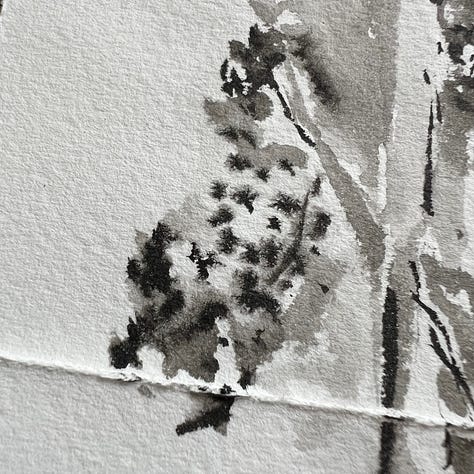
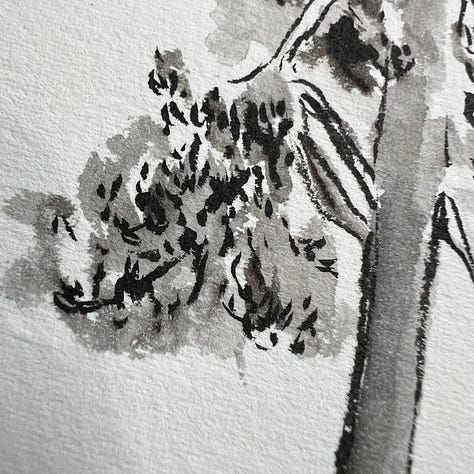
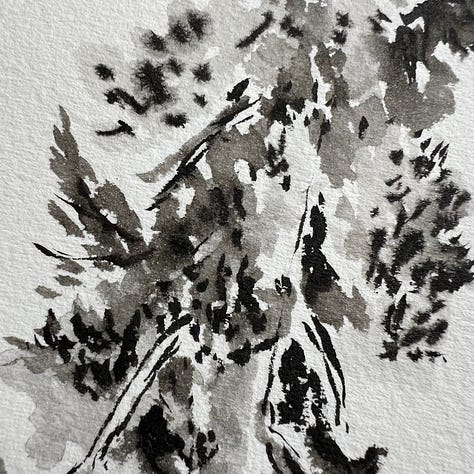
Here’s a video snippet of what it looks like when I sketch trees loosely in my sketchbook.
This is my favorite way of sketching conifers - with brushes. I sketch deciduous trees using a similar minimalist approach - mostly with brushes and only a few colors. If I’m using a pen, then I love to scribble! When I really want to record data like species, shape of leaf, seeds, habitat, etc. I will give more effort towards representing what I see. But for trees at a distance, I’m happy using a more loose and suggestive style.
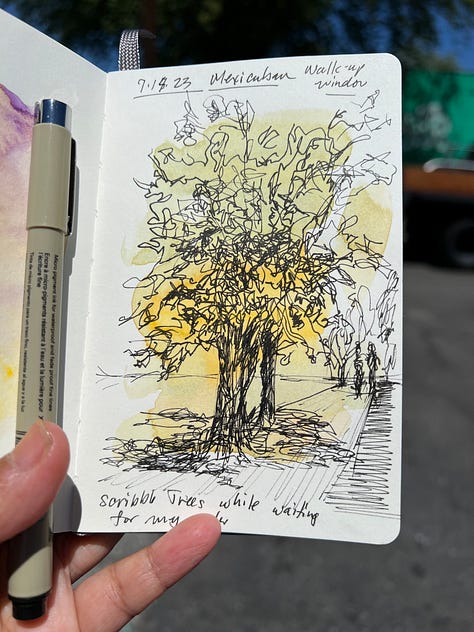

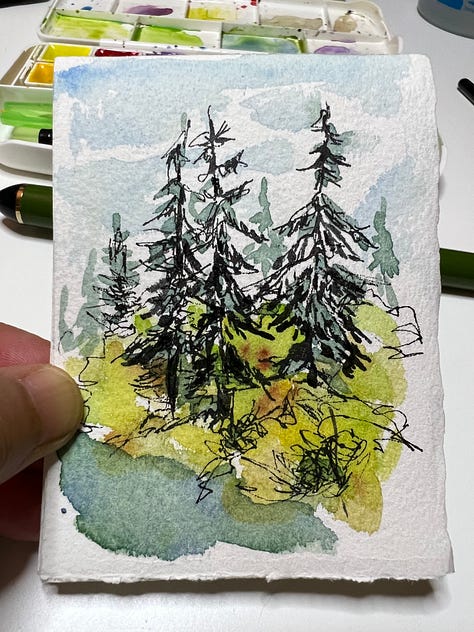

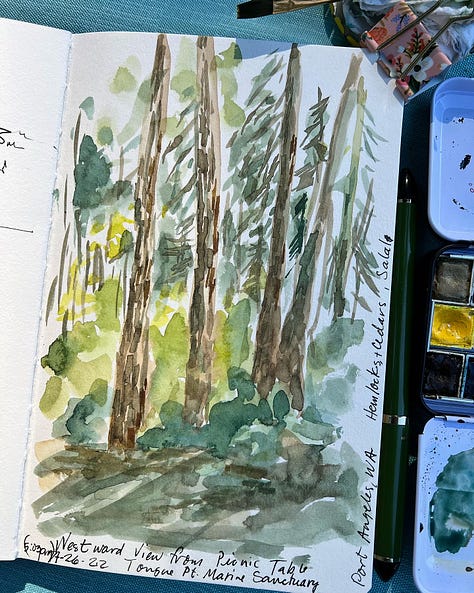
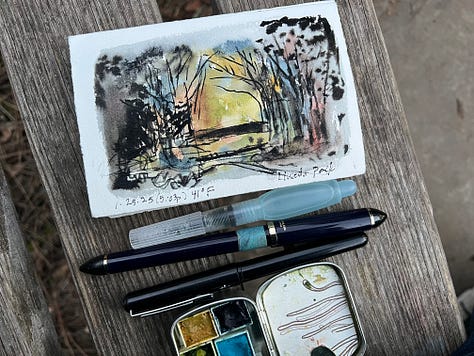
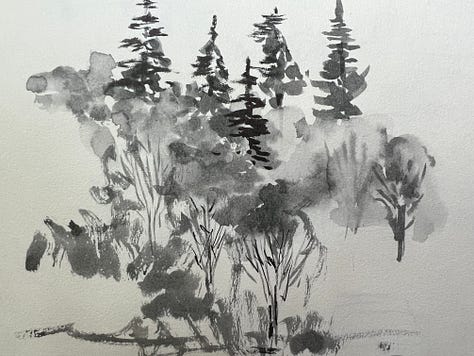
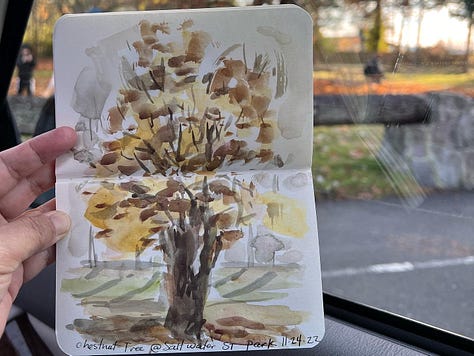
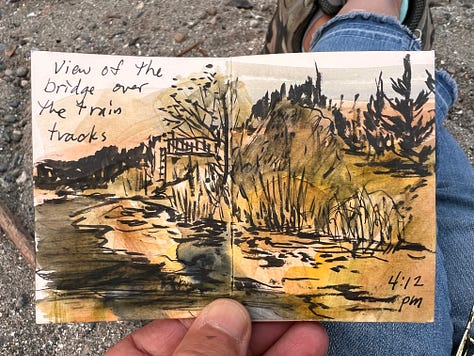
Here’s a photo gallery of loosely sketched trees.
Here’s how I sketch if I want to record closer details.
Photo Caption: A shaded path at the edge of growth of moss draped trees. Two large tree trunk lie in the foreground to the right of the frame.
It makes me a little sad that a walk in the forest must now be prescribed, like modern medicines, to people, given that our current way of living and working, namely enclosed within walls and in cities, rather than out in the open, finding our food or even growing our own food, is just a blip on the timeline of human history.4 It tells me how much we have forgotten (or forsaken) to maintain our modern lives. But I also feel encouraged and validated. We still have trees on earth. They are plentiful in the Pacific Northwest. I have always found being in and among trees personally, a very beneficial experience. I walk in the woods because it feels good and I’m glad I don’t need my doctor to prescribe it to me. I’m also privileged to live near by and have easy access to trees, not just along my neighborhood streets but in city parks and somewhat farther away, publicly accessible forests.
We all can reclaim and remember what our relationship with trees was and shape what that relationship can still be. If trees are not as plentiful in your area, look them up! There are organizations who will help you go to where the trees are. In my area, just one such is the Washington Trails Association.
And in being reminded of all that trees do for life on earth, I remember the 4th of the 4 Questions that I learned from Angel Quimbita of Sea Potential and remind myself to show gratitude to the trees. This means, among many other things, I make sure I don’t take more than I need and I walk gently among their roots, disturbing as little as possible. I invite you to join me.
How did you like this brief sharing of why I love trees and how I like to include them in my nature journal? I would love to know.
If you liked this article and would like to more like it, please consider becoming a free subscriber. Also, sharing is caring!
A Wild Braid Nature Journal is part of A Wild Braid. The mission of A Wild Braid is to help people experience rest and build resilience through nature journaling, guided nature walks, art, learning and community. Rest and resilience, in turn, makes it possible for us to make a better world for all beings.
A Wild Braid is a one-BIPOC-woman owned small business located on Occupied Duwamish and Coast Salish Territory, also known as Seattle, Wa. The best way to support my work is to take a class. You can also make a donation of any size at www.awildbraid.com/support-donate.
A loooooong time ago for me.
Waiting is always easier to do, even pleasurable, when I have something to draw.
I couldn’t even if I wanted to.

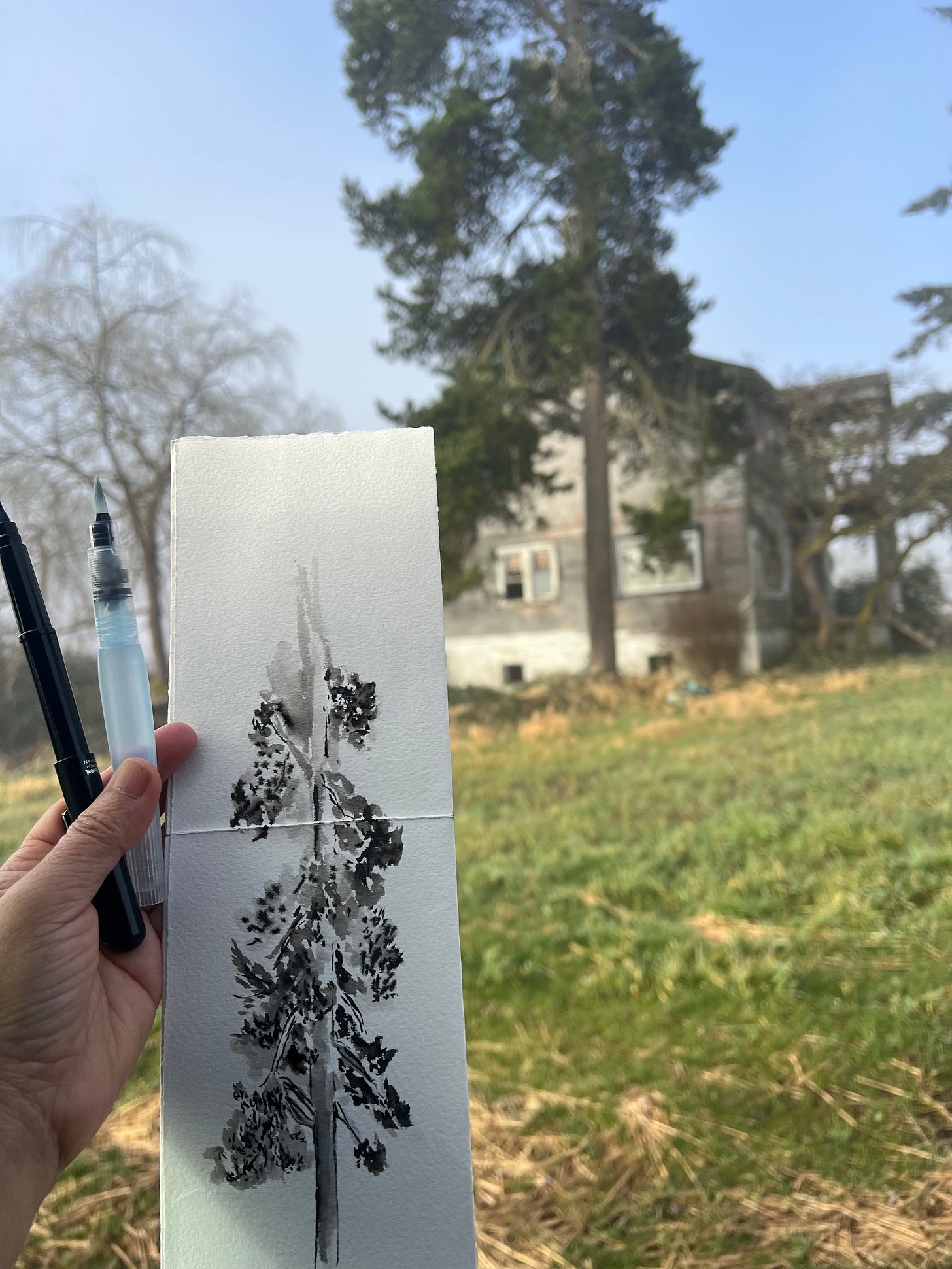

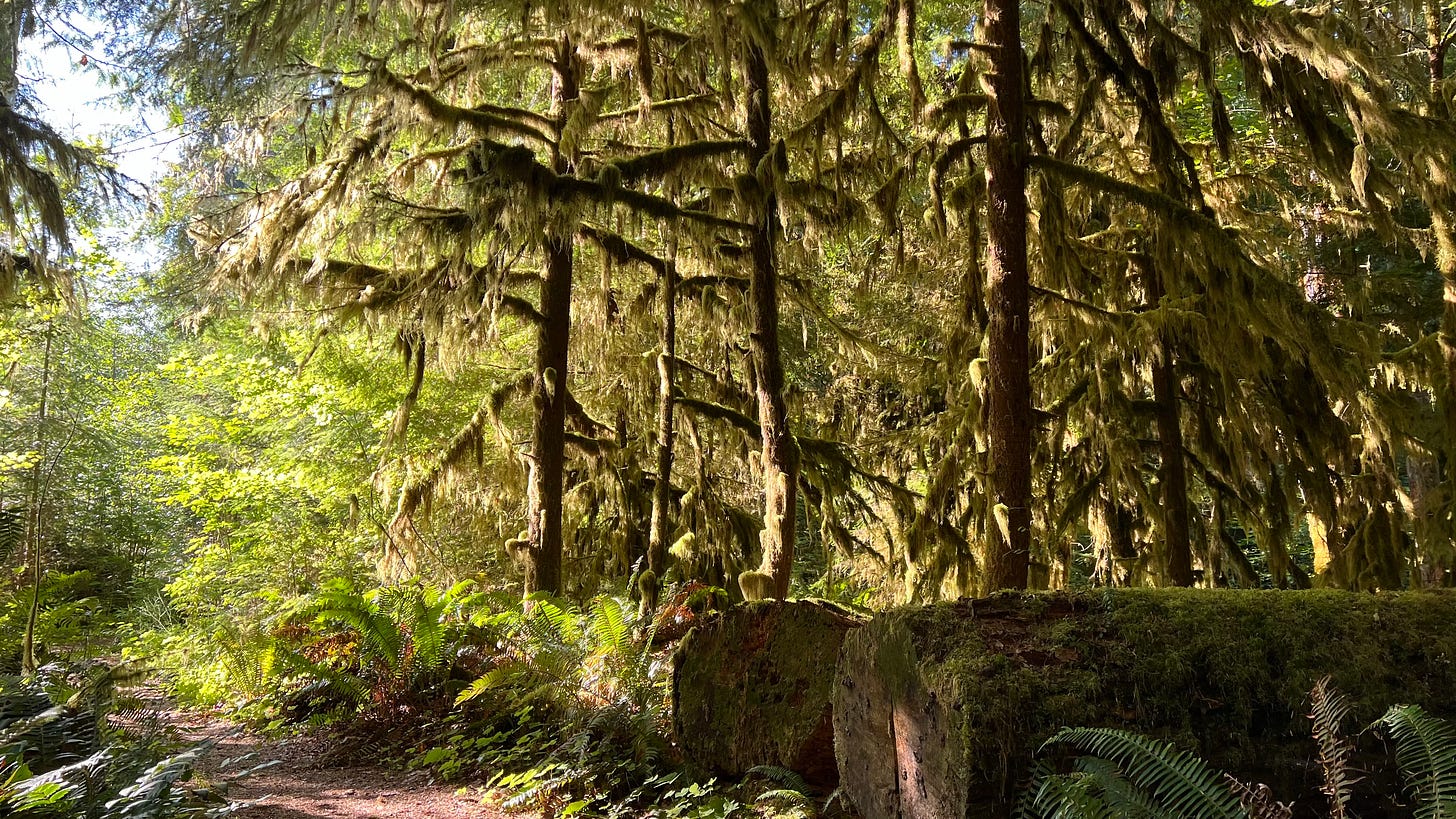
So beautiful! Thank you for sharing your work with us! I'm focusing on painting and reading about trees this year, too. Their presence and longevity is calming, but also a call to action to protect them.
What kind of ink are you using? Is it water-soluble?
We live in the forest so we love trees, hobbits and forest friends! On Christmas we would sometimes have cocoa in the tree house before coming indoors to celebrate. For many of his childhood years we wrote our son a letter signed from the woodland elves and fairies. We would type his letter in tiny print and then stain the paper to look old. We'd roll it up as a scroll and sprinkle gold fairy dust on the floor of his bedroom. I remember my when my son when was maybe 12 saying, "if I ever get a tattoo it will be of a tree." I thought to myself, I can't argue with that choice!